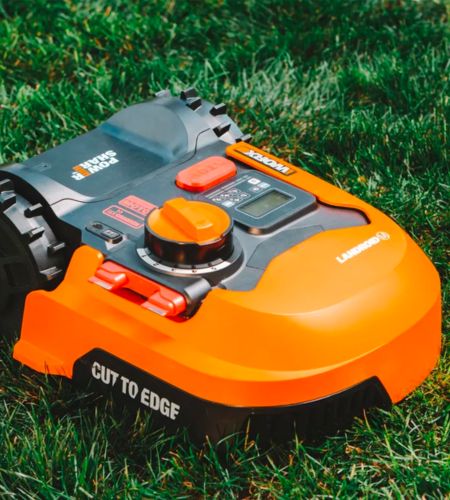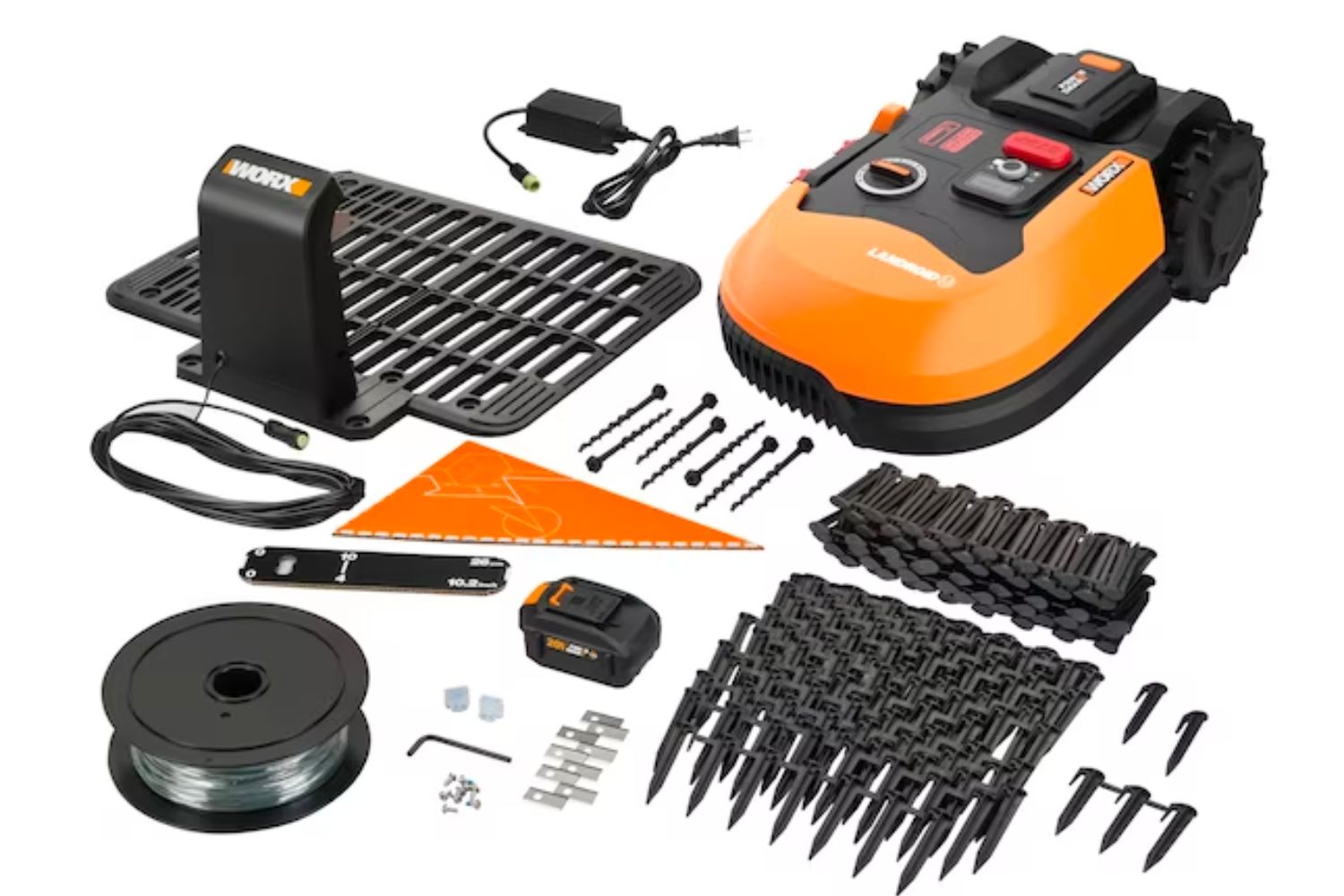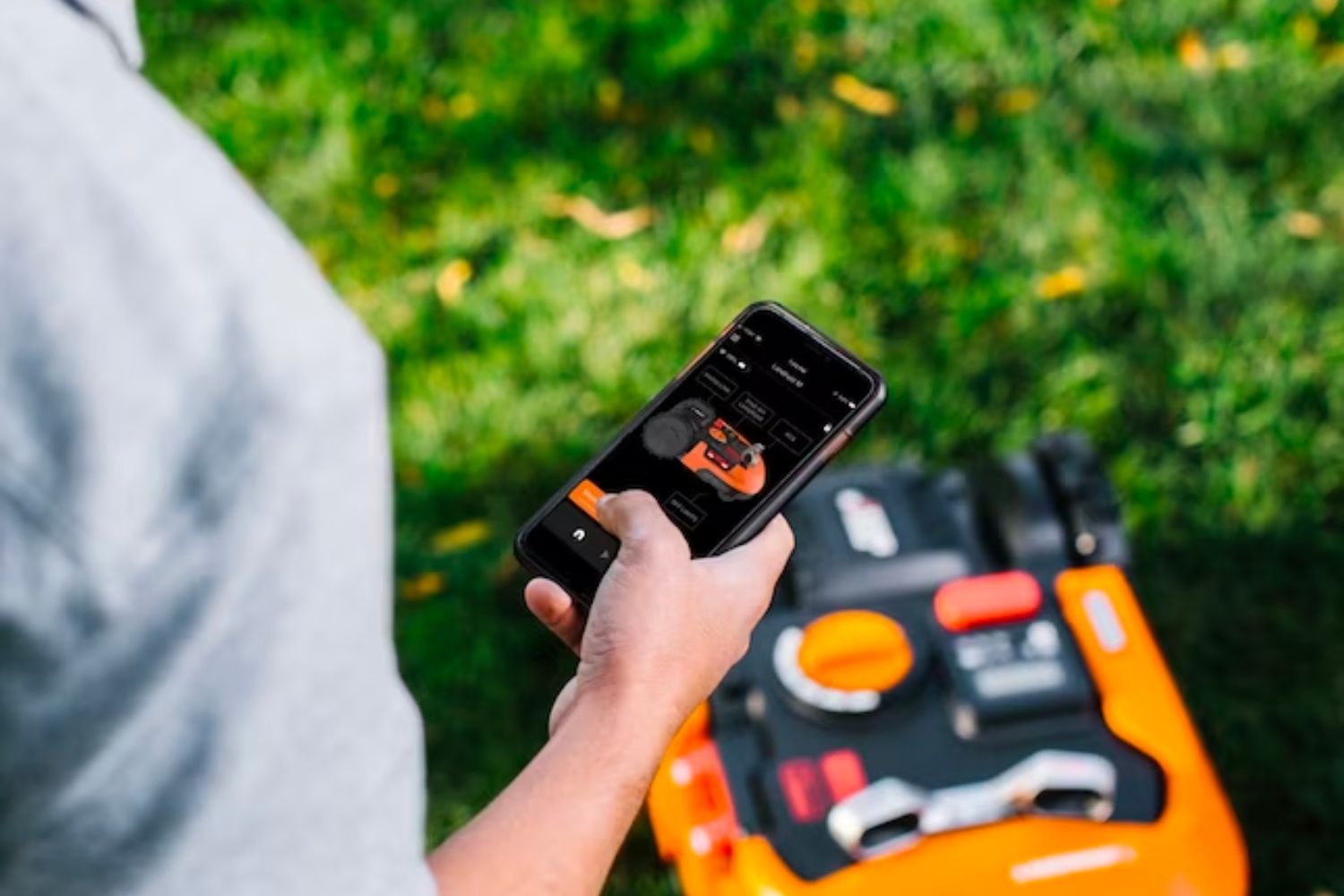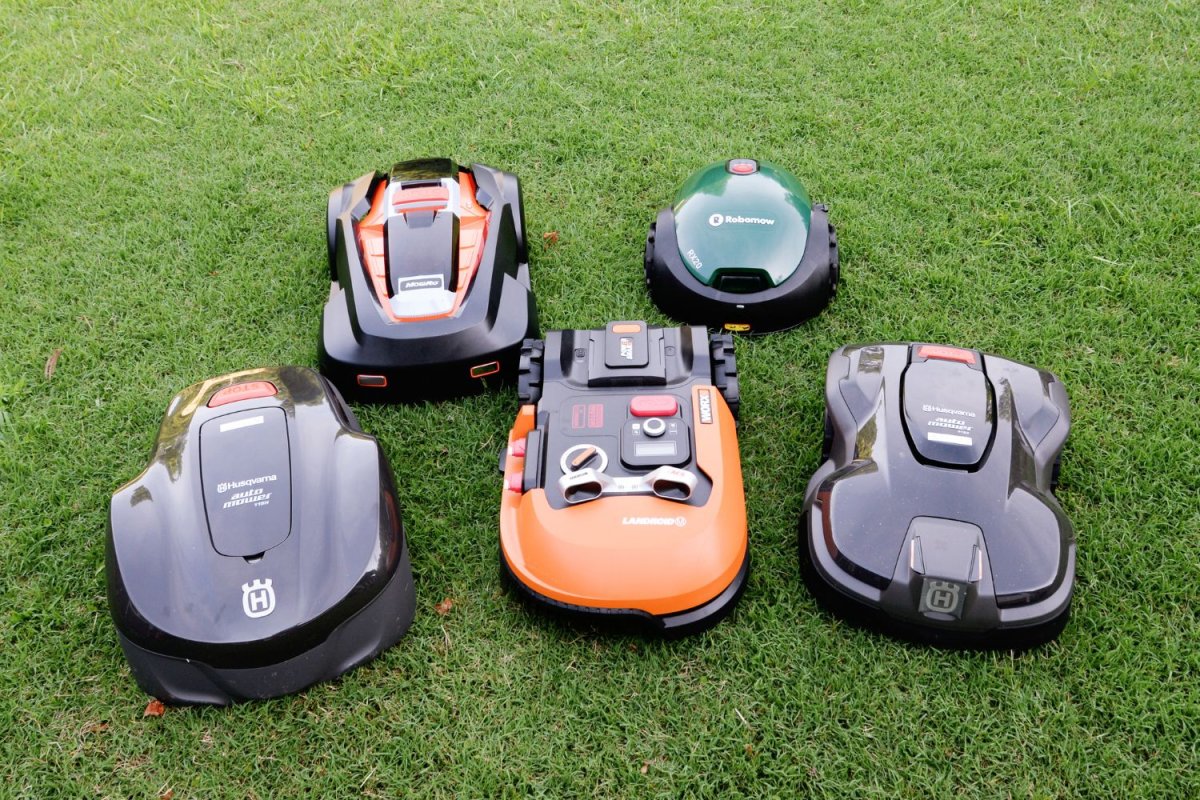We may earn revenue from the products available on this page and participate in affiliate programs. Learn More ›
Most homes have a lawn that needs mowing, but many homeowners dislike mowing. The good news is that a robot can take care of it. After nearly three decades in existence, robotic lawn mowers are finally poised to mow a meaningful percentage of American lawns. In the last dozen or so years, battery technology and software capabilities have matured, and prices have come down to the point where these devices can competently, affordably, and autonomously mow the lawn.
Worx developed one of the first robotic mowers widely available in the United States, the Landroid, and it continues to be one of the most popular choices. The first iteration was released in 2015, and subsequent software, hardware, and connectivity upgrades have improved both the user interface and its mowing ability.
I recently tested a Landroid in my own yard, with a mix of grass types and varied terrain. Its combination of autonomy, remote connectivity, and good basic cut quality made me a believer. In this review, I’ll share my observations and why I think Landroid could be an excellent choice for urban and suburban lawn maintenance.
Worx Landroid M 20V 4.0Ah Robotic Lawn Mower: At a Glance

Rating: 8.9/10
PROS
- Automatically mows up to a half-acre of grass and keeps its own software up to date
- Offers both custom schedules and automated schedules (based on lawn size and conditions)
- Landroid mobile app and Wi-Fi connectivity enable remote control, monitoring, and updates
- Onboard sensors enable navigation around obstacles, down narrow pathways, and over sloped terrain
- Offset blade cuts closer to the edge than other robotic lawn mowers for less cleanup
CONS
- May not dock properly if the charging station is not perfectly flat and level with a level approach
Get the Worx Landroid M robotic lawn mower at:
What is the Worx Landroid robotic lawn mower?
The Worx Landroid is an autonomous lawn mower powered by a rechargeable 20-volt (V) battery. It uses intelligent navigation software to mow in a random pattern while covering the entire lawn over the course of a week. A perimeter wire keeps the mower in bounds as it quietly mows on an automated or customized schedule, which can be anytime, day or night. When mowing is complete, or when the battery runs low, Landroid returns to its charging station.
Landroid’s sensors help it work safely and efficiently. An onboard rain sensor pauses the mowing schedule during precipitation. Bump sensors and the optional Anti-Collision System (sold separately) help it avoid obstacles on the lawn such as toys and patio furniture.
Although users have the option of programming a customized mowing schedule, one of Landroid’s most advanced features is its IoT-based Auto Scheduler. (IoT refers to the “internet of things,” which is the interconnection of objects that have computing devices embedded within them for the purpose of exchanging information over the internet.) It uses features such as lawn size, grass species, soil type, and irrigation, along with weather information, to create a personalized mowing schedule that it constantly adjusts. Once it’s set, users can simply load any exclusions for days or times when the mower is not allowed to work.
Landroid is available in three models: Landroid S is for yards up to 5,445 square feet, Landroid M covers yards up to 10,890 square feet, and Landroid L mows yards up to 21,780 square feet. Although these mowers may be controlled manually with onboard control features, Wi-Fi connectivity and the Landroid Mobile App allow users to monitor and control Landroid from anywhere and to make wireless software updates.
Product Specs
- Coverage: .25 acre
- Mowing height range: 1.5 to 3.5 inches
- Maximum slope: 35 percent or 20 degrees
- Power source: 20V 4.0Ah Worx PowerShare battery
- Runtime: 2 hours
- Recharge time: 1.5 hours

Landroid Setup and Installation
I tested the Landroid M. Setting it up was easy, but details are the key to success. I started by identifying a suitable location for the charging station. The best location is level and flat with a nearby power outlet and a strong Wi-Fi signal. For worry-free docking, it’s important to provide a straight, flat approach to the charging station, as I discovered after about three mowing cycles. Do not position the station in a “bump out” that would require the mower to make a turn in order to enter.
In addition to setting up the base station that comes with the mower, I also had to set up the Landroid Garage (sold separately). This accessory covers the mower while it is in the charging station. Landroid is designed for the elements, but the added protection increases longevity by shielding the mower from UV rays, falling debris, and summer heat. It only added a minute or two of assembly time, as it shares ground anchors with the base.
In addition to assembling the base and plugging in the power, I installed the Anti-Collision System (sold separately) on the mower and placed the mower on the charger. Then I downloaded the mobile app and paired the mower with the app. Total time for this portion of setup was about 15 minutes.
Next, I installed the boundary wire, which starts and ends at the charging station. I started by unrolling and laying the wire loosely around the edges of the yard and any permanent obstacles like trees and landscape islands. Then I used the included anchor stakes and spacer template to secure the boundary wire in place. It is also acceptable to lay the boundary wire in a shallow trench, or under new sod. The spacer template helped me maintain adequate distance between the wire and actual boundaries and barriers, which is a key detail since the mower has to drive a short distance over the wire before it receives the signal to stop and change direction. Installing the boundary wire took about an hour and a half.
Landroid Connectivity and Security Features
A strong Wi-Fi connection allows users to get the most from the Landroid. It uses a 2.4GHz signal; 5GHz signals are not supported. After downloading the mobile app (available for both iOS and Android devices), I jotted down my Wi-Fi network SSID (service set identifier) and password. Then I opened the app, scanned the QR code on the mower, and followed the prompts to add the mower to my app. The process was easy to follow and only took a couple of minutes.
Though I did not test it, another optional feature is the Landroid Radio Link module. It serves as a signal extender to maintain a constant internet connection. The radio link securely extends the home Wi-Fi signal more than half a mile, even penetrating walls. The transmitter connects to your router and the receiver plugs into the Landroid. For technical help, Worx offers a thorough troubleshooting page that answers questions in detail.
Several additional security features protect the mower for added peace of mind. As is the case for other robotic lawn mowers, access to the controls is guarded by a personal identification number. Additionally, an app-controlled lock may be used to disable the manual controls, so that only those with app access can operate the mower. The optional Find My Landroid is a cellular module that uses GPS to track Landroid’s location and recover it in the event that it is stolen.

Using the Landroid Mobile App
The Landroid app is intuitively built, easy to use, and includes some extra helpful features. From the home screen, I could simply hit the “Play” button to instantly start mowing, the “Pause” button to temporarily stop, or the “Home” button to cancel mowing. Even with automated and programmed schedule options, I found that mowing on demand was one of the app features I used most frequently.
Other manual mowing functions included “Edge Cut” to clean up the grass along perimeter wire, “Party Mode” to suspend the normal mowing schedule, and “One Time Schedule” for an additional custom mowing—as many hours as you designate—outside the normal schedule.
I used some other areas of the app a bit less frequently. The “My Landroid” area shows which Landroid you are controlling and allows you to select another if you have more than one. The “My Lawn” section is where you upload information for auto scheduling, and it includes features to assist in measuring the lawn size and also identify grass type and soil type. That is also where you can set up multizone mowing, enable the “Save the Hedgehogs” feature (which prevents nocturnal mowing), and control the rain-delay feature. The “Activity Log” and “Statistics” areas allow you to monitor Landroid’s mowing activity. “Settings” is where you can choose or change your location and also enable and prioritize notifications.
Mowing With the Landroid Robotic Mower
Landroid did a great job mowing my yard. It consistently mowed on schedule; stayed within the boundary wire; navigated around obstacles; traversed moderate slopes and uneven terrain; and produced a nice, even cut.
The only challenge I had was with the charging station alignment. After startup, everything seemed fine. By the third mowing, however, the Landroid could not find its way back to the charging station. I realized that my setup was not straight or flat enough, and the mower was slipping away from the charger contacts, which caused it to continue moving around the perimeter wire, as if it was trying to find its way “home.” After I made a few adjustments to the charging station assembly, everything worked out fine.
Having used manual scheduling for the first test week, I allowed Landroid to auto schedule for the second week. The auto schedule mowed slightly less frequently than the one I had used, but the cut was better. I also noticed the mower’s ability to self-adjust its schedule. I had originally programmed one 2-hour cut per day. After 7 days, the auto scheduler had settled into its own twice-daily routine, which was about 50 minutes per cut, plus two edge-cut cycles per week. The lawn appearance was similar, but the auto scheduler spent less total time mowing.
The only lingering question I had was how Landroid would interact with an irrigated lawn. Since the built-in rain sensor sends the mower home whenever rain starts, I envision complications when the auto scheduler is used in a yard with an automated sprinkler system. One option would be to override the rain sensor. Another would be to create a custom schedule that is coordinated with the irrigation schedule. A third option would be to let the mower operate on auto schedule and run the irrigation system manually when needed. In any case, those with sprinkler systems will want to consider the possibility of conflicts.
Is the Worx Landroid worth it?
When it comes to price, it’s not difficult to show the value of buying a robotic lawn mower. In my experience, the cost for a weekly lawn service to mow an average suburban lot can range between $40 and $60 or more per visit, or between $1,040 and $1,560 for a full season (about 26 weeks). At that rate, Landroid pays for itself in a single season. For those who do their own lawn maintenance, switching from a conventional lawn mower to a robot is all about time savings. If it takes an hour a week to mow the lawn, then Landroid could eliminate up to 26 mowing hours or more each year, depending on the climate you live in.
Compared to other robotic lawn mowers, at a price range of $999.99 to $1,499.99, Landroid is not the cheapest option available, but it is also not the most expensive. It does the basic job of lawn mowing very well, includes standard control features that are typical of more expensive competitors, and offers convenience and security upgrades to boost its functionality.
Consider competitors like the Husqvarna Automower series. At about $700, the entry model Automower 115H cuts up to .4 acre and navigates slopes up to 30 percent. It’s probably one of the best deals in terms of basic robotic mowing, but it only offers Bluetooth connectivity to its mobile app while the user is standing within about 30 feet of the mower. The Landroid L mows a slightly larger area, is easier to monitor and control from anywhere, and offers more customizable settings. The added connectivity and customization that come with the Landroid justifies the difference in price, and these features also offer a better user experience.
Is the Worx Landroid right for you?
Robotic lawn mowing is still very new to most of us, and it’s always a good idea to take a look at emerging technology. If you are in the market for a new lawn mower, I would recommend taking a closer look at robotic lawn mowers in general and the Worx Landroid in particular. These devices offer a compelling combination of labor savings, low emissions, low maintenance, and reliability when it comes to caring for your lawn.
In my backyard, the Landroid robotic lawn mower performed the basic task of mowing as well as, or better than, the competitors that I tested. It comes equipped with smart technology that continually improves mowing performance and operational efficiency as it gets to know your yard. The ability to connect and manually control the mower from anywhere is an advantage that most other robot mowers at this price point cannot match. If you have a small to midsize suburban yard and you are considering buying a robotic lawn mower, Landroid could be a great pick.
Where to Buy the Worx Landroid Robotic Lawn Mower
Get the Worx Landroid M robotic lawn mower at:
Meet the Tester
Mark Wolfe is a writer and product tester with an extensive background in the nursery and landscaping industry. For more than 20 years he mowed, edged, planted, pruned, cultivated, irrigated, and renovated beautiful landscapes. Now he tests and writes reviews about the latest outdoor power equipment, hand tools, lawn-care products, and other outdoor-living goods.


